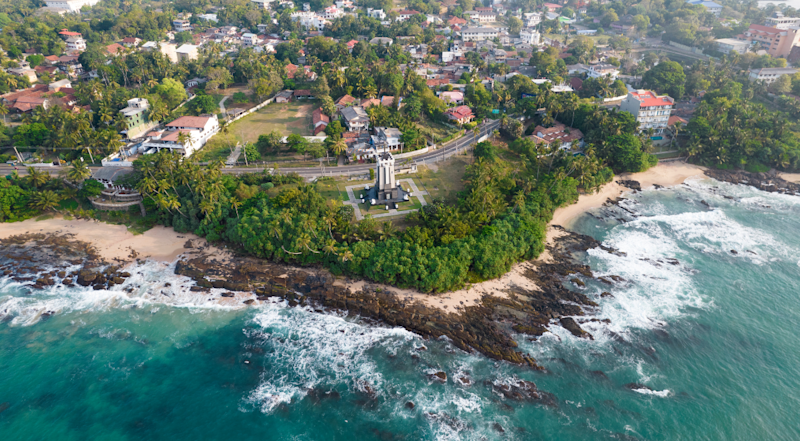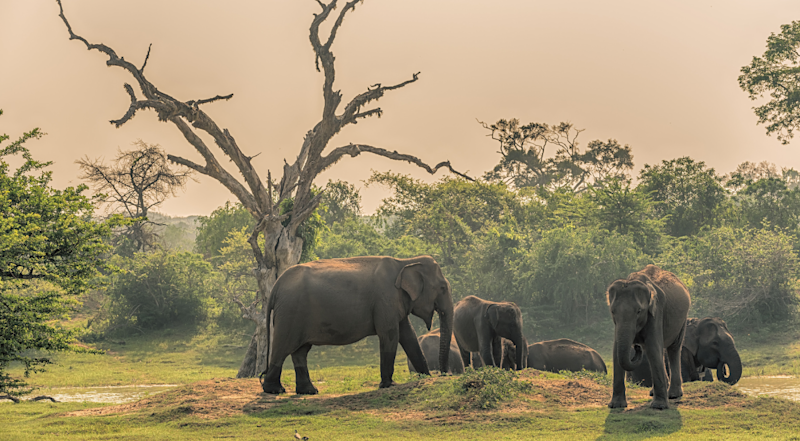Sri Lanka weather is anything but predictable in the traditional sense. With two monsoon systems, contrasting coastlines, and dramatic elevation changes, the island packs a surprising variety of climates into a space smaller than Ireland.
One minute you’re on a sun-drenched beach in Mirissa, and a few hours later, you’re pulling on a sweater in misty Nuwara Eliya. To make the most of your trip, you need more than a basic weather forecast for Sri Lanka—you need a real strategy.
This guide breaks down the Sri Lanka climate zone by zone, highlights the best time to visit Sri Lanka depending on what you want to do, and shares accurate, up-to-date Sri Lanka temperature insights to help you pack smart and plan better.
Whether you're after dry-season beach days or cool mountain mornings, knowing how the monsoons move is the key to unlocking the island’s full potential.
Understanding Sri Lanka’s tropical climate
Sri Lanka weather isn’t one-note. In this compact island, two monsoon seasons and several microclimates turn every journey into its own adventure. You could wake up to bright sunshine on the coast, then slip into a misty mountain morning just hours later.
- Yala Monsoon (May–September): Delivers afternoon showers on the southwest coast (Colombo, Galle, hill country). Mornings stay clear, so plan early beach walks or hikes.
- Maha Monsoon (October–January): Brings steadier rain to the northeast (Trincomalee, Jaffna). If you’re chasing the sun, head south or west during these months.
No matter the season, you’ll find somewhere dry. Chasing the least soggy spot is half the fun.
Sri Lanka temperatures vary more than you might expect. Along the coast, daytime highs hover between 77°F and 88°F (25°C–31°C). In the hills—think Kandy or Nuwara Eliya—temps can dip to 60°F–77°F (15°C–25°C), offering a cool escape from the humidity.
Humidity never takes a day off, but it fuels verdant jungles and thundering waterfalls. Embrace the glow. And if you need real-time updates, a quick weather forecast Sri Lanka search will keep you one step ahead. We suggest sites like AccuWeather or the Department of Meteorology Sri Lanka.
Best time to visit Sri Lanka
The best time to visit Sri Lanka really depends on where you're headed and what you want to do. Since the island’s weather is shaped by two separate monsoon systems, different regions shine at different times.
Here's your no-nonsense cheat sheet based on the Sri Lanka climate:
- South & West Coast (Colombo, Galle, Mirissa): Dry, sunny, and perfect between December and March
- East & North Coast (Trincomalee, Arugam Bay, Jaffna): Prime season from May to September
- Hill Country (Kandy, Ella, Nuwara Eliya): Best explored from January to April
If you're chasing the sun or planning hikes, beaches, or tea trails, these windows align with the most stable Sri Lanka weather in each zone.
Shoulder seasons can be a steal
If a bit of rain doesn’t bother you—and let’s face it, it rarely lasts all day—April and October to November can be fantastic. These shoulder seasons offer fewer crowds, discounted rates, and just enough sunshine to keep your plans intact. They're perfect for travellers who want more value and don’t mind packing a light rain jacket.
Monthly weather guide for Sri Lanka
Because of its equatorial location, Sri Lanka temperature stays pretty consistent year-round, ranging from 78°F to 90°F (26°C to 32°C) on the coasts and 59°F to 68°F (15°C to 20°C) in the highlands. But rainfall patterns change everything.
Here's what the Sri Lanka climate looks like month by month:
January to March – Beach days and clear skies
This is peak season for a reason. The south and west coasts are drenched in sunshine, making it ideal for:
Rain is scarce, sunsets are dazzling, and the sea is calm. If you’re planning a beach holiday, this is hands-down the best stretch of Sri Lanka weather—just book early, because it’s also the busiest time of year.
April to June – Warmer days, surprise showers
By April, temperatures rise, especially inland. The Yala monsoon starts to roll in around May, bringing short but intense afternoon rains to the southwest. Still, the days often start out dry and sunny, so there’s plenty you can do:
- Surfing in Arugam Bay (as the east begins to dry)
- Touring tea plantations in the central highlands
- Climbing Sigiriya Rock before it gets too hot or wet
It’s a transitional season, but the Sri Lanka temperature remains warm and welcoming.
July to September – Dry days in the east
While the southwest coast gets a little soggy, the east and north hit their sweet spot. This is when Sri Lanka weather flips:
- Arugam Bay becomes a surfing hotspot
- Trincomalee is perfect for snorkeling and whale watching
- Jaffna offers drier skies and fewer tourists
If you're after sunshine, this is the east coast’s time to shine. The Sri Lanka climate here is hot and dry, with minimal interruptions.
October to December – Rain returns, festivals light up
The Maha monsoon kicks in from the northeast, soaking the north and east. But the south and west start to dry up again by December, just in time for the holidays.
October and November are great if you want:
- Fewer crowds in major tourist areas
- A shot at weather forecast Sri Lanka roulette (sun one hour, drizzle the next)
- Cultural events like Diwali and the lead-up to Christmas
By mid-December, the southern beaches come back to life, making it a beautiful time to end the year with a mix of sun, surf, and festive celebrations.
Looking for more things to do in Sri Lanka? Take a look at this guide that suggests the top 20 things to do in Sri Lanka.
Regional weather highlights
Colombo
Sri Lanka’s capital delivers the full tropical experience—hot, humid, and alive with energy year-round. This coastal city is best enjoyed between January and March, when sunshine dominates and the sea breeze keeps things bearable. If you’re not a fan of flash floods or surprise afternoon showers, skip May and October, when the monsoons make the Sri Lanka weather forecast a little more unpredictable.
Here is your complete guide to Colombo.
Kandy
Set high in the hills, Kandy is cooler and more laid-back than the lowlands. It’s ideal from January to April, when the skies are clear and the tea estates are vibrant. Evenings can dip into the low 60s°F (around 16°C), so pack a light jacket. Whether you’re temple hopping or strolling the lakefront, this part of the Sri Lanka climate offers a welcome break from the coastal heat.
Jaffna
In the far north, Jaffna serves up dry, sunny days for most of the year. Your best window is May to September, when the northeast is basking in stable weather. The Maha monsoon shows up from October to January, but rainfall here tends to be lighter than in the south. With fewer tourists and steady Sri Lanka temperatures, it’s one of the island’s best-kept secrets.
Galle
Historic Galle mixes Portuguese charm with palm-lined beaches—and a healthy dose of tropical rain depending on when you go. The best time to visit this coastal gem is December through March, when blue skies are almost guaranteed. From May to September, expect heavier showers, thanks to the Yala monsoon. That said, the upside is fewer crowds and lush, green scenery.
Why is Sri Lanka such a unique destination? Because every region offers magical experiences—rain or shine—filled with culture, fun, and something to see or do wherever you go.
What to pack for Sri Lanka weather
Don’t be fooled by the island setting—Sri Lanka weather isn’t one-size-fits-all. Microclimates mean you’ll need to pack a bit of everything to stay comfortable from coast to mountains.
Essentials:
- Light, breathable fabrics like cotton or linen (humidity is no joke)
- Compact umbrella or lightweight rain jacket
- Comfortable walking shoes or sturdy sandals
- Reef-safe sunscreen and insect repellent (trust us—mosquitoes love tourists)
- A sweater or light jacket for cool evenings in the hill country
- Waterproof pouch or dry bag for phones and cameras during sudden downpours
Pro tip: Sri Lankans tend to dress modestly, especially in temples and rural areas. You’ll fit in better—and show respect—by covering shoulders and knees in these spots.
For a complete Sri Lanka packing checklist, click here.
FAQs about Sri Lanka weather
Q. Is it always hot in Sri Lanka?
A. For the most part, yes. Coastal areas stay warm and humid year-round. But places like Nuwara Eliya in the highlands can dip into the 50s°F (±10°C), especially at night. Layer up if you're heading inland.
Q. Can I travel during monsoon season?
A. You can—and many do. The key is choosing the right coast. Thanks to Sri Lanka’s dual monsoon system, there’s almost always a dry region to explore. Rain tends to come in bursts rather than lasting all day.
Q. When is Sri Lanka most crowded?
A. December to February is peak season, especially along the south and west coasts. If you’re planning a trip during this time, book early—accommodation fills up fast.
Q. Does it ever get cold?
A. Not by most standards, but if you’re heading to the central highlands, don’t underestimate the chill. Evening Sri Lanka temperatures in places like Ella or Kandy can surprise you.
Q. Is the weather predictable month to month?
A. To an extent. Patterns follow the monsoons, but tropical weather can be full of surprises. Keep an eye on the weather forecast for Sri Lanka as you plan, and always have a backup plan—or a good book and a covered balcony.
Follow the sun to Sri Lanka
Whether you’re here to surf, sip tea, explore ancient ruins, or unwind under a coconut tree, Sri Lanka weather can shape your entire trip. With two monsoon seasons and dramatically different climates from region to region, timing is everything. But that’s also what makes the island so rewarding—there’s always a sunny corner waiting to be explored.
Not sure where to start? We’ve done the legwork. Check out Follow Alice’s Sri Lanka tour for expertly planned adventures that follow the best of the Sri Lanka climate—so you spend less time dodging storms and more time making memories.





